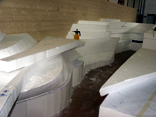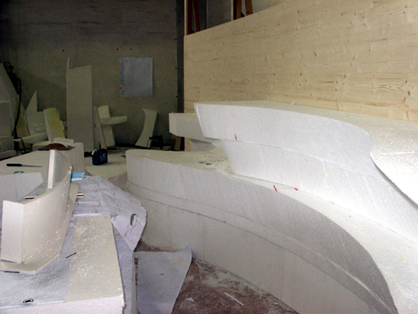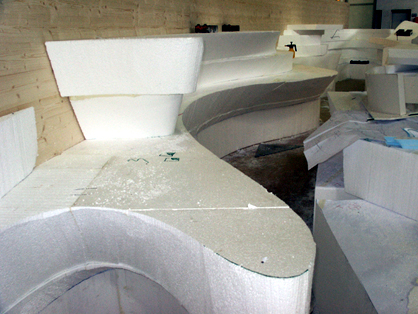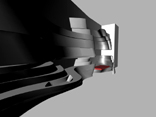|
sito + "/AREA=" + sezione + "/AAMSZ=" + misura + "/ACC_RANDOM=" + bumber + "/PAGEID=" + pageid + "'>"); document.write(""); |
| home > allestimenti |
|
sito + "/AREA=" + sezione + "/AAMSZ=" + misura + "/ACC_RANDOM=" + bumber + "/PAGEID=" + pageid + "'>"); document.write(""); |
| home > allestimenti |
| Mutations.
Abstract Spaces/Virtual Utopias Patrik Schumacher |
||||
| Si
apre oggi a Graz, nell'ambito dello "steirischer herbst",
la mostra Latent Utopias a cura di Zaha Hadid e Patrik Schumacher.
ARCH'IT presenta l'iniziativa attraverso i contributi di Patrik Schumacher,
che illustra i contenuti del progetto allestitivo nel quadro della più
generale organizzazione teorica della mostra, e di Filippo
Innocenti (SPIN+) che descrive i criteri espositivi adottati nella
presentazione delle opere selezionate. [PG] |
||||
| LATENCIES
WITHIN CONTEMPORARY EXPERIMENTAL ARCHITECTURE The exhibition brings together a series of important experimental architectural projects by established as well as by emerging architects (and architectural teams). The featured projects venture into a fascinating realm of radical abstraction and utter strangeness. What is the hidden meaning and potential purpose of these creative practises? How does this "new avant garde" relate to the old questions of progress? Is it possible to unearth a utopian potential here? Every time needs its utopia(s). A society that does no longer reflect its development is uncanny, a monstrosity. However, utopian speculation is rather dubious today. In recent years the very notion of progress and the ambition to project a future has itself come to be regarded as monstrous. Utopian thinking seems naive, dangerous hubris. |
[26oct2002] | |||
   |
  The history of (built and unbuilt) Modern Architecture has been paraded as villain and quoted as a symbol for the vanity of failed utopian claims. But however one judges the radical concepts (concerning the structure and morphology of the modern, industrial city) that were formulated at the beginning of the 20th century by Tony Garnier, Le Corbusier, Ludwig Hilberseimer and Frank Lloyd Wright etc., they have shown an unbelievable anticipatory power. After 50 years of runaway success and world wide adoption the (utopian) projections and principles of the modern heroes can hardly be discussed as "mistakes", even if the socio-economic transformations of the last two decades -achieved on the back of the material advances of the modern period- mean that the social ideals, desires and requirements with respect to the architecture of the contemporary city have since developed in radical anti-thesis to the modern utopias. |
 |
||
| What
are the new needs, demands and questions that contemporary society raises
for architecture and urbanism? Are there protagonists that take up this challenge within their creative practise? There is no easy or immediate answer here. In the last 10-15 years the discourse of the architectural avant-garde was driven by the principle of negativity. Concepts like de-construction, dis-location, de-coding and de-territorialization have been dominating the scene. Apparently positive concepts like plurality, multiplicity, heterogeneity and virtuality are defined in opposition to the key concepts of modernity and signal the end of universality, predictability and of any notion of a (future) ideal order. There is no sense any more in projecting and articulating the Zeitgeist. Every architectural concept or trope is relative with respect to divergent perspectives and interests. Every architectural form multiplies in the kaleidoscope of multiple, temporary audiences. The total social process has become far too complex to be anticipated within a single vision and utopian image. Other strategies are called for. MUTATIONS |
||||
 |
The
unpredictability of emergent socio-economic patterns spells the impossibility
of straightforward goal orientation in planning and design. In the face
of this predicament there is a necessary strategic retreat from the
immediate program of progress. The flipside of this impossibility of
straightforward progress is the necessity (and the freedom) to experiment,
providing the rationale for an unheard of proliferation of new formal
possibilities. What one is left with is the (nearly) random production of the new and "other", without yet being able to make the claim to provide measurable improvements. A phase of pure mutation is introduced whereby the selection and reproduction of the new material points beyond the capacity of the individual author towards a collective process of appropriation. In various fields of research and professional work, not least in architecture, the necessity to incorporate random mutations into strategies of innovation has been asserted in practise and starts to be reflected in theory. |
|||
  |
 The role of chance discoveries in the progress of science and technology is long since proverbial without systematic acknowledgement on the part of epistemology. Even today the notion of random pursuits rings antithetical to notions of strategic conduct or rationality. Nevertheless, in the history of science as well as in recent design methodologies, a new notion of rationality crystallises. Groping experimentation, the incorporation of random play and a margin of undetermined, uncontrolled investment are now seen to be necessary ingredients of any strategy aimed at innovation. |
|||
 The radical architectural projects presented here are not offering themselves as utopian proposals in the sense of elaborated proposals for a better life. They do not claim to have a meaning in this sense. They pose questions and withdraw the familiar answers. They are open-ended mutations that at best might become catalysts in the co-evolution of new life processes. (Of course there is also the risk to remain alien to everything and everybody. That risk has to be taken.) Experimentation is not necessarily to be confined to the design process, but might continue in the building itself. Who is to judge and deny a priori that a strange building will not attract and engender a strangely productive occupation? Such speculative investment might become accepted as intervention research. What to many yet appears as an assemblage of disjointed trials and tribulations, might soon cohere into a worthwhile development. A decoded architecture -made strange- offers itself to inhabitation as an aleatoric field, anticipating and actively prefacing its own detournment. We raise the question of the new needs, demands and purposes that the new architecture might address with respect to contemporary society. The answers might well be discovered within the various formal experiments that are proliferating today. The latent social content of the new, strange, abstract spaces that are on the drawing boards of the current architectural avant-garde(s) may be teased out within an interpretative framework that forces the issue of playful collective appropriation and detournment within mutated scenarios of another "everyday life". This is the thesis and ambition of our exhibition (and book). Patrik Schumacher |
  |
|||
|
All the pictures above are related to the Big Wave installation presented at the Latent Utopias exhibition by Zaha Hadid, Patrik Schumacher (Zaha Hadid Architects). Collaborators: Natalie Rosenberg, Thomas Vietzke. |
||||
|
La
sezione Allestimenti laboratorio
|